Land Sailing in Nevada
January – February 2013
By MATTHEW B. BROWN
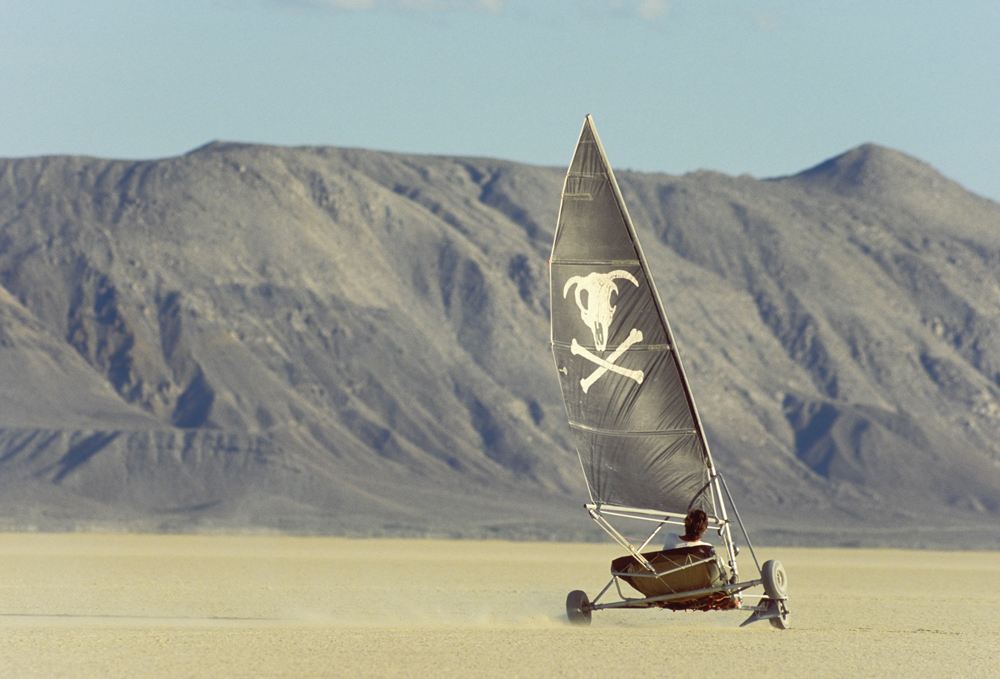
Nevada has many claims to fame, and you can add one more to the list: land sailing. In fact, I was interested to learn recently that the Silver State is arguably the premier land-sailing destination in the United States.
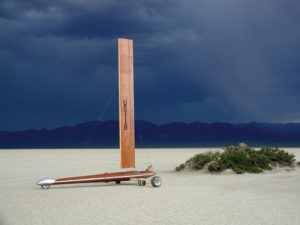
“We have the dry lakebeds, the hard mud,” says nine-time national champion and current treasurer of the North American Land Sailing Association, Mark Harris. “Nevada is a very popular location because we can go the fastest.” Nevada also has wind galore, which is as valuable to a land sailor as fuel is to a racecar driver.
Land sailing, also known as sand yachting or land yachting—or as Harris likes to call it, “dirt boating”—has evolved primarily into a racing sport in the last half century. Its roots can be traced as far back as 6th-century China. Centuries later, some European royalty used land yachts for entertainment, and they were even used hundreds of years ago in the U.S. to transport goods.
Today, however, they are used primarily for competition. Land-sailing events are held internationally from the vast beaches of Western Europe, Ireland, New Zealand, and Brazil to the dry deserts of the U.S. It’s no surprise then that the arid sands of Nevada have become the epicenter of the fiercely competitive dirt-boating world.
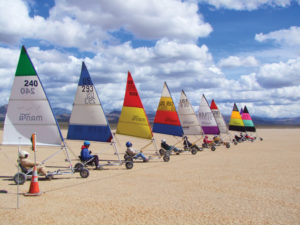
OK, maybe that’s a bit of an exaggeration. “It’s friendly competition,” says Harris, an electrical engineer for the Public Utilities Commission of Nevada. “The Europeans are big on entertainment, so that tradition has carried over to the states.” The sense of community and family is strong in land sailing. Harris says a group of spectators and racers, which rarely exceeds 100 at most events, will enjoy potluck dinners, fly remote-control airplanes, hold stargazing parties, and socialize around bonfires.
The next major Nevada event is America’s Landsailing Cup (this and most others are open to the public) on March 23-30 at Ivanpah Dry Lake, just south of Primm—a shopping and entertainment destination known for its Primm Valley Resorts and Desperado roller coaster.
Richard Jenkins set the world land speed record for a wind-powered vehicle (126.2 mph) there on March 26, 2009 in his yacht Greenbird. The previous record of 116.7 mph was set at Ivanpah in 1999.
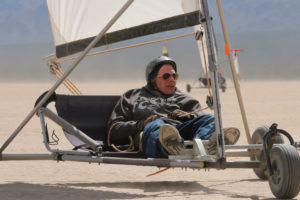
While Ivanpah is technically in California just over the Nevada border, it’s still largely considered a Nevada event because Primm is the gateway. Other Silver State terrain used primarily for land sailing includes Misfits Flat, just south of Stagecoach; Smith Creek Valley Dry Lake southwest of Austin via State Route 722; and Diamond Valley northeast of Eureka via S.R. 278.
On the NALSA website there are images from the 1998 “Holy Gale” event held in the Black Rock Desert. The Thrust SuperSonic car (jet-powered in this case) famously bolted across northwestern Nevada’s Black Rock Desert in 1997 at a world-record speed of 763.035 mph, or 2 percent above the speed of sound.
The annual Holy Gale has since moved to Smith Creek Valley, which is Nevada pilot Lester Robertson’s favorite event. Robertson is the owner of the aforementioned Misfits Flat land—where much of the famous 1961 film starring Marilyn Monroe was filmed—and the Carson City company Complete Millwork Service.
Robertson loves the competition of land sailing, but he also cites, “the silence of the desert; just setting down these contraptions, accelerating, and seconds later flying along at 50 mph in a cloud of dust,” he says. “The dust subsides, and you will find yourself five miles from camp without a breath of wind, hoping for the next puff to come in and take you home.”
Robertson, who heavily promotes youth land sailing, also speaks highly of the camaraderie that is such a big part of the sport’s makeup. “A lot of guys and gals have been friends for years—the same bond you find with the rock hunters, rocketeers…all of us waiting for the next year’s trips to the heart of Nevada, the Great Basin.”
Black Rock Goes Soft
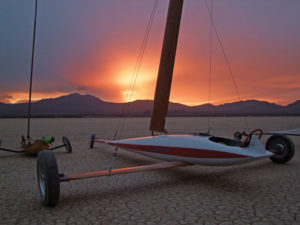
The Black Rock Desert in northwestern Nevada was once a premier land-sailing destination, but that’s not so anymore. The key, believe it or not, is moisture—or lack thereof. “It has not flooded since 2000 or thereabouts,” says Nevada pilot Lester Robertson. “Four years ago the surface went from so hard you did not leave imprints with your motorhome tires to so soft and crumbly a 250-pound dirt boat would sink so deep you cannot sail.”
According to Robertson, the Black Rock needs a substantial flood covering after which the water would soak deep into the subsurface. “Perhaps this will be the year we get the type of snow and rain we had when the Truckee River flooded and the Helms pit became Sparks Marina; that’s what it will take to repair the Black Rock Desert,” he says.

